2010 June
About Andrew Cusack
 Writer, web designer, etc.; born in New York; educated in Argentina, Scotland, and South Africa; now based in London.
Writer, web designer, etc.; born in New York; educated in Argentina, Scotland, and South Africa; now based in London. read more
News
Blogs
Reviews & Periodicals
Arts & Design
World
France
Mitteleuropa
Knickerbockers
Argentina
The Levant
Africa
Cape of Good Hope
Netherlands
Scandinavia
Québec
India
Muscovy
Germany
Academica
In a Westchester auction house
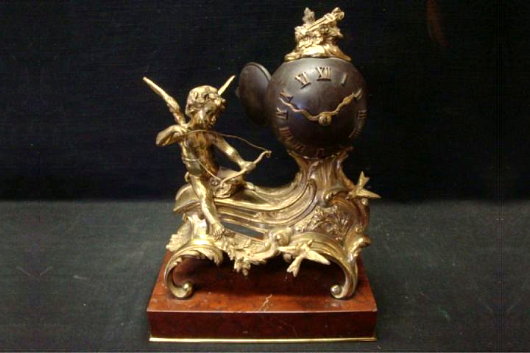
Saturday I popped in to have a friendly chat with Paterfamilias Gill, of which the usual topic of conversation is the decline of civilisation and the amusing side effects thereof. We had reached Afghanistan when Mrs. Gill eventually joined us, and, after showing me the latest addition to the Gill collection (a splendid maritime scene by William Edward Norton), Mr. Gill suggested an expedition to the auction house down a back alley in neighbouring Larchmont, and I happily agreed.
Above is a gilt bronze and patinated metal clock in the French style. I’m rather fond of the curvature of spherical clockfaces, and the serpentine hands are a nice detail as well. This clock would fit in at 15 East Ninety-sixth Street. Estimate of $800-$1,000. (more…)
Three for the Army
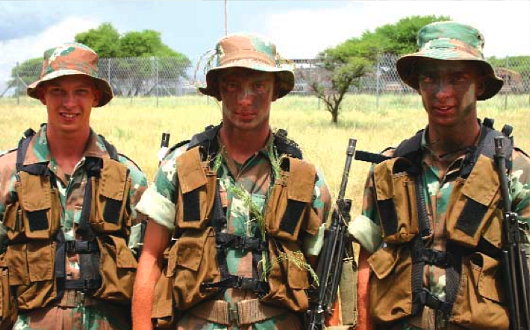
Something you don’t see every day: a set of triplets from Pretoria recently completed basic training as part of their enlistment in the South African Army. Dirk van Zyl, Tjaart van Zyl, and Hendrik van Zyl (above, left-to-right) are 20 years old and got their mechanical engineering qualifications before enlisting in the Defence Force.
The three brothers are all part of Foxtrot Company, 3 South African Infantry Battalion based at Kimberley in the Northern Cape; Hendrik in Platoon 1, Tjaart in Platoon 2, and Dirk in Platoon 3.
Large-scale operational deployments of the South African military have been few and far between since the country withdrew from the Angolan conflict and granted Namibia independence. Since then they have mostly consisted of United Nations and African Union peacekeeping operations, as well as other endeavours such as South Africa’s 1998 military intervention in a dynastic dispute in the neighbouring Catholic monarchy of Lesotho. Current defence regulations prevent siblings like the van Zyl brothers from being operationally deployed simultaneously.
Alexander Stoddart: “An Elite for All”
Scotland’s national newspaper interviews Scotland’s national sculptor
By SUSAN MANSFIELD
The Scotsman | 22 November 2008
ALEXANDER STODDART welcomes me into his studio, and into the 19th century. “It hasn’t gone away, you see,” he says, brightly. “The 19th century is not a period in time, it’s a state of mind.”
Indeed, if one could visit the workshop of one of the great monumentalists of a century ago, it might look a lot like this: plaster casts in various stages of assembly; imperious figures missing limbs or, occasionally, a head; bags of clay which until recently were a working model of physicist James Clerk Maxwell.
Stoddart is Scotland’s premier neo-classical sculptor, the man who made the figures of Adam Smith and David Hume for Edinburgh’s Royal Mile, Robert Burns for Kilmarnock, the beautiful Robert Louis Stevenson memorial on the capital’s Corstorphine Road. He’s 49, but looks boyish, with his sandy hair and dusty lab coat cut off at the elbows. He is a man of swift, enthusiastic intelligence, rarely still, and almost never silent.
Despite once being dismissed by the Scottish Arts Council as “backward-looking, historicist and not reflecting contemporary trends”, Stoddart is busy. Around us are the plastercasts of past commissions: immense allegorical figures for the £6 million Millennium Arch in Atlanta, Georgia; religious commissions for a mysterious private client who has her own chapel “somewhere in North Britain”; parts of 70ft frieze for Buckingham Palace. A bust of Pope John Paul II for a Chicago seminary.
Soon they will be joined by James Clerk Maxwell, whose statue, commissioned by the Royal Society of Edinburgh, will be unveiled on Tuesday at the East End of Edinburgh’s George Street. Stoddart is thrilled to be sharing a street with 19th-century sculptural greats like John Steel’s Thomas Chalmers. “It’s the greatest honour to be anywhere near the company of Steel.”
And he is ready and waiting for the next question, the one about relevance. (more…)
‘Handmade’ by Xavi García
‘A reaction to the soullessness of digital design’
Not many artists or designers have a business degree from Salamanca or studied management in Gothenburg. Xavi García has, though, and it’s obvious his grounding in the financial realm had an influence on his personal art project ‘Handmade’ — a banknote meticulously created by hand using drypoint, screenprinting, and stamps on newsprint. García describes the project as “a reaction to the soullessness of digital design”. (more…)
Carbuncle Alert in Queens

Our carbuncle alarm, which went haywire over the Brooklyn Museum’s offensive new entrance, has alerted us to a new monstrosity nearing completion in the adjacent borough. (more…)
München: mees bewoonbare stad

Hoeveel kere het ek dit hoor sê? München, die Beierse hoofstad, is die mees bewoonbare stad in die wêreld volgens baie lyste deur talle mense saamgestel. Die meeste kenmerk hierdie status aan die unieke kombinasie van tradisie en moderniteit in die stad. Beiere het ’n balans getref, en die Beierse mense is baie trots op hul land — en tereg! Müncher weißwurst — bedien met mosterd en ’n krakeling — is my gunsteling wors. (Jammer, boerewors! Jou Duitse neef is tops.)
In elk geval, op die webtuis van Monocle tydskrif, Tyler Brûlé het ‘n blik op München en ondersoek waarom en ondersoek waarom het dit so ‘n goeie reputasie. Kliek hier om te kyk.
It is scandalous that in all my travels I’ve never been to any part of Germany, let alone Bavaria, considering how everyone raves about it unceasingly. Once I finally get myself to the other side of the pond permanently, it’s high up on the list of places to visit pronto (alongside the Netherlands and Finland). All in good time, all in good time…
A Palace on Princes Street
The North British & Mercantile Insurance Company, No. 64 Princes Street
PRINCES STREET IS the thoroughfare of the nation, and its sad decline during the second half of the twentieth century and only partial comeback since then are reflective of Scotland itself. The architects of Edinburgh’s New Town had no idea that Princes Street would evolve into a commercial avenue, and the street was originally laid out as a handsome row of Georgian townhouses, built between 1765 and 1800, facing Princes Street Gardens and the Old Town above behind them.
Almost immediately the mercantile and social nature of the street began to assert itself, with shops and traders setting themselves up in the converted basements and ground floors of townhouses. The New Club showed up at No. 86 Princes Street in 1837, coming from previous premises in St. Andrew’s Square and before that Shakespeare Square (where the former G.P.O. now stands).
As the Victorian era progressed, more and more of the Georgian townhouses were demolished and replaced with new buildings in the varying styles of age. It was just two years after Victoria’s death that an old company built a new headquarters in a brimming Edwardian baroque: the North British and Mercantile Insurance Company. (more…)
The World Cup Preserves Something America is Losing
The drama of sport is being systematically attacked by the bloated American Pro-Sports-Statistical-Media Complex. I can name for you three specific ways that this is happening, but there are doubtless more. First, a universal obsession with statistics. A common criticism of American culture is that it is so technological and empirical that you can’t say anything without backing it with numbers. But I have come to the darker conclusion that most sports broadcasters talk about numbers only because they have nothing else to say. I really don’t care, I really think it is meaningless, that the Chiefs have not succeeded in making a two-point conversion during the third quarter of a post-season game in the last five years. The quintessence of this obsession was illustrated this week by Bob Ley of ESPN, in the halftime analysis during the Argentina-Nigeria World Cup match. “The last time Argentina gave up a halftime lead was in the 1930 World Cup,” he said. “It just doesn’t happen.” This baffled the Spaniard Roberto Martinez, an ESPN commentator and former professional soccer player, who responded: “That was a different team, Bob.” Sports teach us that the possible is greater than the probable; statistics applied to sports is probability’s revenge on possibility.
The second destructive force is the delusion of the Instant Replay. We appeal to the camera when we become afraid of the human element in sport. We think that the precision and justice that the replay can provide for us will defuse the pain that is intrinsic to any competitive sport. In games we see that the best-trained can’t always play their best, and that those with the best eyes don’t always make the right call; the imprecision and the deficiency are also elements in the drama. The Instant Replay is an attempt to quell the drama, as if sports would be better without it. All it actually does is stir confusion about what a game really is, and every time we interrupt a game to watch a video, we strike a blow at the soul that keeps the game moving.
Interruptions, also, are what television commercials are. That basketball and [American] football are structured in such a way as to accommodate for television commercials is a scandal. Who enjoys watching “The Godfather Part II” when it is sliced and diced by ads for sitcoms and acne medication? The interruptions wake us up from the dream of the drama; basketball and football lose something in this constant interruption.
All of this may sound bleak, but the answer to it is flickering in a billion television screens worldwide this month. As we watch the World Cup this summer, we should be conscious that we are witnessing a sport that is resisting. It resists, if nothing else, the tyranny of television commercials. No commercials interrupt the 45 minute flow of a half of soccer—there are no “TV time outs.” The narrative builds and is resolved within continuous time, and it demands that we reclaim the patience and the attention spans most of my generation lost sometime in the late 1990s.
Moreover, even though every now and then somebody within FIFA complains that Instant Replay should be introduced into the game, most fans accept that the game includes injustices. We suffer through them, and we play again the next day. Geoff Hurst scored a “goal” for England in the 1966 Final which actually did not cross the line. Maradona scored a “goal” with his hand against England in the quarterfinals of 1986 (he attributed it to God; five minutes later, he scored the greatest goal in World Cup history). France would not be in the World Cup this year, and Ireland would be, had Thierry Henry not handled the ball during a qualifying match. What can you do? Better to make a sacrifice than to kill the sport.
As for statistics—American soccer broadcasters, too, are beholden to them. But one could always learn Spanish and switch to Univision.
The World Cup this year has its own set of stories which will congeal into the dramatic. The Brazilian squad has betrayed its principles of jogo bonito (beautiful play) and has adopted a pragmatic approach which yields victories without flair. Ironically, the German side looks more playful and creative in attack than Brazil does. Lionel Messi of Argentina will be trying to live up to his reputation of being the greatest Argentine player since Maradona. And there is a tough Paraguayan side you will not want to miss.
Most importantly, there is a drama that you will not want to miss—one that retains certain human elements which are besieged in our hyperactive media age.
Alice von Hildebrand on Life
This superb lecture to a high-school audience by Alice von Hildebrand, the retired Professor of Philosophy at Hunter College of the City University of New York, was sent to me by an acquaintance at the University of Caen in Normandy (a town I had the pleasure of visiting some years ago).
The speaker is the widow of the famous Prof. Dietrich von Hildebrand, and speaks with a fascinating insight tempered by good humour. I thought I’d just listen to a bit of it but became entranced and couldn’t tear myself away from it.
Mrs. von Hildebrand covers an astonishing variety of subjects but the animating focus of the lecture is the relationship between body and soul, and how that is reflected in the relationship between man and woman.
“It’s a privilege for an elderly person to share her experience with young people,” Mrs. von Hildebrand says. “It’s a very special joy to share with you the gifts I have received.” However privileged the speaker feels, I’ve no doubt it is rather the listeners who are privileged to hear so a woman of such great wisdom speak to them at so young an age.
I know one of the most memorable interactions I ever had was with the Polish freedom fighter and Auschwitz survivor Jozef Garlinski when I was just sixteen years old — the late Mr. Garlinski’s most important lesson continues to exert a profound influence over me, and was one that I have always remembered at the more trying times in life since then.
These students are blessed to receive such an important life lesson.
The Houses of Parliament, Dublin
The Physical Incarnation of Ireland’s Golden Age
THE OLD HOUSES OF PARLIAMENT in Dublin are probably at the top of my list of favourite buildings in the world. Now the headquarters of the Bank of Ireland, it has a long and varied history, and its exterior composition is one of surprising unity for a structure the components of which were designed by three architects. It is supposedly the first purpose-built parliament building in the world, and stands on the site of Chichester House, a stately home adapted for use by the Irish Parliament from the 1600s onwards.
The location, with a history dating back centuries, is just south of the Liffey river upon what was then known as Hoggen Green. A nunnery existed on the site which was supressed during Henry VII’s Dissolution of the Monasteries. A large private house was then built on the site, set back from the street, eventually known as Chichester House. (It likely incorporated some of the old convent’s structure). Among the esteemed inhabitants of the house were Sir George Carew, sometime Lord President of Munster, Sir Arthur Chichester, after whom the house was named, and the Anglican Bishop Edward Parry is known to have had a lease on the place during his lifetime.
The building must have been seen as holding some public significance, not only because it was located adjacent to the University of Dublin (of which Trinity College is the sole constituent institution), but it was home to the Irish Law Courts for a time beginning with the Michaelmas legal term of 1605. Towards the end of the seventeenth century, no later than October 1692, the Irish parliament began to meet at Chichester House on College Green. (more…)
Holland in die Kaap
’n Groep van Nederlanders in die Kaap het hulle Volkswagen Beetle in die Hollandse patriotiese kleure geverf om hul steun in die Sokkerwêreldbeker te vertoon en hul het hierdie vrolike YouTube video gemaak ook. (Hulle blog, in Nederlands, is 34 graden Zuid).
Watter span steun ek? Ach, baie! Teen Engeland, het ek die Verenigde State gesteun (maar ek haat die “Anyone-But-England” houding van baie in die Britse Eilande buite Engeland). Teen Duitsland, het ek die Aussies gesteun. En natuurlik al die Maties moet BAFANA BAFANA steun!
So vir groepe A-H (onderskeidelik) ons is vir Suid-Afrika, Argentinië, die VSA (of Engeland), Australië, Nederland, Nieu-Seeland, niemand in groep G, en Chili.
An “Unknown Delegate”?!?!?
It’s Bilderberg 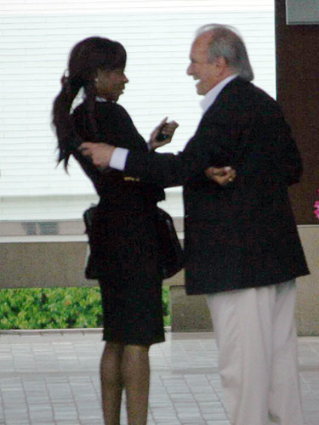 season again, which normally has all the conspiracy theorists this side of Roswell up in a flurry. This year, however, the organisers have cheated by having a website and even a press release concerning the proceedings. The Guardian has a photo gallery of the various guests arriving, mostly attired in the tiresome suit-but-no-tie combination which has become all too prevalent of late.
season again, which normally has all the conspiracy theorists this side of Roswell up in a flurry. This year, however, the organisers have cheated by having a website and even a press release concerning the proceedings. The Guardian has a photo gallery of the various guests arriving, mostly attired in the tiresome suit-but-no-tie combination which has become all too prevalent of late.
The super-trendy left-wing newspaper, however, demonstrates its typically Euro-centric mindset through its caption for this photo: “Francisco Pinto Balsemão, a former prime minister of Portugal and the CEO of Impresa, says goodbye to an unknown delegate.” An “unknown delegate”?!?!? That’s no less than Dambisa Moyo, the most famous Zambian in the world (referred to as “our girl” in Zambian newspapers), not to mention author of a New York Times bestseller and African star-of-the-hour for over a year now. Honestly, Mr. Guardian!
Unbuilt Cape Town: Municipal Offices
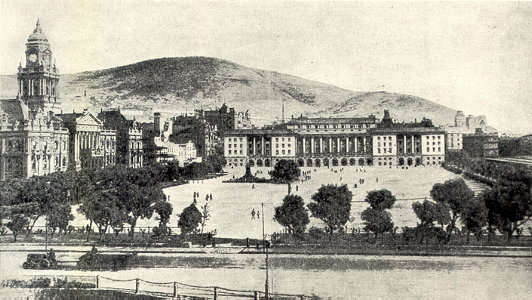
UNBUILT ARCHITECTURAL PROPOSALS fascinate me. Unfortunately most of the books documenting the more prominent examples of unbuilt buildings focus on space-age hyper-modernist ideas that never got off the drawing board, but these tend towards the tawdry and ridiculous. Far more interesting are the rejected proposals for buildings that did get built — for example the rival schemes to rebuild the Palace of Westminster after the 1834 fire — or this example of a proposal for a building never executed. I came upon these scheme thanks to the uploads of the Flickr user Berylmd. While Cape Town has a splendidly grand City Hall in an Edwardian Baroque style, the city fathers were unwise in providing insufficient space for the ever-blossoming municipal bureaucracy. This plan would have put a new municipal office building spanning the entire western side of the Grand Parade, replacing those little unremarkable market buildings whose existence on the square persists to this day. (more…)
4 de Junio
On June 4, 1943, 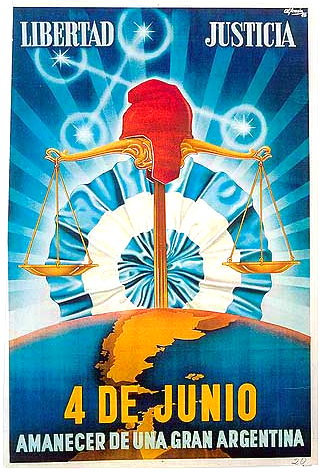 a murky group of Argentine military officers called the GOU (standing for United Officers’ Group, or Government, Order, Unity) overthrew President Ramon Castillo and ended the Década Infame, or ‘Infamous Decade’ that had begun with the 1930 coup against Hipólito Yrigoyen. The ’43 coup was led by General Arturo Rawson, who served as President of Argentina for a month before being replaced by the more politically minded Gen. Pedro Ramírez.
a murky group of Argentine military officers called the GOU (standing for United Officers’ Group, or Government, Order, Unity) overthrew President Ramon Castillo and ended the Década Infame, or ‘Infamous Decade’ that had begun with the 1930 coup against Hipólito Yrigoyen. The ’43 coup was led by General Arturo Rawson, who served as President of Argentina for a month before being replaced by the more politically minded Gen. Pedro Ramírez.
Ramírez sympathised with the Axis powers in the Second World War, and his inability to successfully maintain Argentina’s neutrality in the face of U.S. pressure led to his resignation and succession by Gen. Edelmiro Farrell, who was viewed by most as the instrument of his charismatic junior, the infamous Col. Juan Perón (with whom we are all too familiar).
This poster produced by the junta incorporates a number of the symbols of Argentine patriotism and nationalism. ‘Liberty’ and ‘Justice’ are proclaimed the principles of the junta, and underneath the date of the coup is announced the ‘Dawn of a Greater Argentina’. The Phrygian cap of liberty, a frequent Argentine emblem, rests atop the scales of justice while the stars of the Southern Cross imply a divine favour over the new regime.
The map of Argentina coloured in yellow includes the British colony of the Falkland Islands and Antártida Argentina, the Argentine Republic’s claimed possession on the Antarctic continent (which overlaps with competing claims by Chile and the United Kingdom). Behind the whole composition, the Argentine Cockade looms ascendant like a rising sun, affirming the text’s proclamation of a new dawn under the nationalist-revolutionary regime.
The TLS Online
I hope that one byproduct of the Times of London moving to a new website is that the Times Literary Supplement will finally get one of its own. Other Times spinoffs like Times Higher Education and the Times Education Supplement have them, so why not the jewel in the crown?
Also, I’d hate to see my pedantic letter to the editor of October 1, 2008 available only to paying subscribers (see here, scroll down to ‘Banking’, and ignore erroneous spacing).
Come on, TLS. If the LRB can do it, so can you.
Googlebosch
Google Street View Comes to the Eikestad and all South Africa
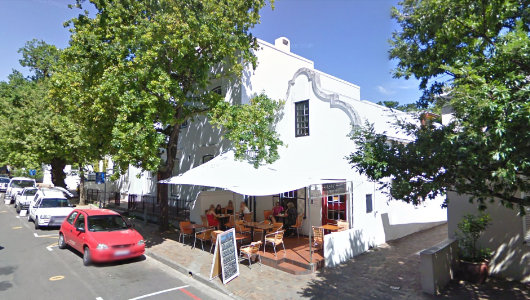
There had been rumours for a while. Talk had spread around the land of strangely equipped vehicles criss-crossing the country, and now the whole world can access Google Street View for South Africa. Naturally, they haven’t managed to capture every street in the whole country, but Cape Town, the Peninsula, and the Boland are well-covered, which naturally includes the handsome town of Stellenbosch that I used to call home. This of course provoked a mini-tour of the Eikestad and environs to see all the old familiar places. Above is Basic Bistro, the finest establishment in town, where one would oft find me planted outside with a pot of rooibos and the day’s edition of the Cape Times or Die Burger. The little alleyway to the right led to the back entrance to my old place. (more…)
Facebook Page
As some of our readers will have already noticed, andrewcusack.com now has a Facebook page you can join.
Our Cardinal Strikes Again
Cardinal O’Brien, Scottish Primate, Preaches at Newly Ordained Priest’s First Mass in the Extraordinary Form at St. Mary’s Cathedral Edinburgh
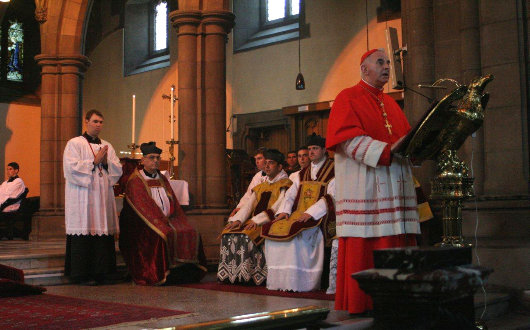
Keith Patrick O’Brien, the Primate of Scotland and Cardinal Archbishop of St Andrews & Edinburgh, this weekend preached at the first mass offered by the recently ordained Fr. Simon Harkins of the Priestly Fraternity of St. Peter. The mass was offered in the Cardinal’s own Cathedral of St. Mary in Edinburgh, Fr. Harkins’s own home town. The Very Rev. Fr Josef Bisig FSSP and the Very Rev. Fr. Franz-Karl Banauch FSSP assisted, and monks from the Transalpine Redemptorists of Papa Stronsay (who provided these photos) were also present, in addition to a number of diocesan priests.
I’ve spent the past eight years of my life divided between three (arch-) dioceses and I have to admit that Cardinal O’Brien is still the one I feel the greatest affection for. He’s an affable, uncomplicated fellow, and can be relied upon to defend what’s right in the media — unquestionably one of the best prelates in Britain today.
“I find him a much more approachable figure than other Scots prelates,” writes Damian Thompson, “less inclined to stand on his dignity despite (or perhaps because of) his red hat. I met him once at a party to relaunch the Scottish Catholic Observer, to whom he’s been a good friend; he didn’t sweep in surrounded by flunkeys, but hung around chatting in ordinary priest’s dress, reminding me a bit of Basil Hume in that respect.”
As it happens, I’m head of Cardinal O’Brien’s fan club on Facebook, which I encourage any Facebook users out there to join.
God bless our cardinal, and many congratulations to Fr. Hawkins! (more…)
Clarity on Torture
Those who see abortion as an evil are often frustrated by those who attempt to justify abortion by vague arguments about “choice” or even more practical arguments about exceptions for rape or incest, or the health of the mother. But many of these same people lose their moral clarity when the subject is torture. Suddenly they are the ones bringing up exceptions and parsing definitions.
There is so much confusion over this issue that in a recent TV interview, a prominent Catholic journalist let a former Bush Administration speechwriter, also a Catholic, grossly misrepresent Catholic teaching in a shameful apologia for torture.
Let us re-establish clarity. Torture, whether physical or psychological, is a barbaric, savage act, not justifiable under any circumstances, and unworthy of a civilized society.
But don’t take our word for it. For those readers who are religious, the Evangelical Lutheran Church in America began calling for America to cease torturing prisoners more than a year ago. American Episcopal bishops agree, as do other Protestant denominations. For our Catholic readers, Pope Benedict XVI wrote, “I reiterate that the prohibition against torture cannot be contravened under any circumstances.” The Catholic Church draws no distinction between physical and psychological torture.
For those readers who aren’t religious, we turn to U.S. law and international law, where torture is, without exception, condemned. Not one state or municipal law enforcement agency permits it. The Army Field Manual, which regulates interrogations by the U.S. military, prohibits torture. So does the Geneva Convention—a treaty to which both the Holy See and the United States are signatories. None of these institutions or documents draws any distinction between physical and psychological torture either. For all, torture is torture.
When Catholics and Protestants agree, and when religious and secular institutions agree, that torture is an offense against human dignity and that those guilty of it should be thrown in jail, may we not agree that perhaps it is immoral? Do we really need to get into the nuts and bolts of what constitutes torture?
Yes, we do. Most will agree that taking a power drill to a man’s shoulder or pulling out his fingernails with pliers for punishment or to extract information is torture. But when the subject is waterboarding, clarity vanishes again. Some consider waterboarding to be mere psychological torture—which, as we’ve already established, is morally indistinguishable from physical torture.
But waterboarding is not a harmless dunk in the tub, as former Vice President Dick Cheney once likened it, and it is not psychological torture. In waterboarding, a subject is strapped to a gurney. His feet are elevated slightly above his head. A cloth is draped over his face. And water is poured on his face so that it enters his nose and mouth and flows into his lungs. CIA interrogators are instructed to pour the water immediately after a detainee exhales, to ensure he inhales water, not air. They use their hands to “dam the flow” of excess water from a detainee’s mouth. And detainees who are scheduled for waterboarding are put on a liquid diet, to minimize the risk of death should they inhale their own vomit.
This procedure became official American policy in our so-called War on Terror, but it was not always so. Waterboarding has been condemned by the United States government since at least 1898, when American soldiers were court marshaled for waterboarding prisoners during our occupation of the Philippines following the Spanish-American War. In World War II, we hanged Japanese war criminals for waterboarding American and Allied troops. In the 1980s in Texas, a sheriff and three of his deputies were convicted by the Justice Department for waterboarding prisoners to extract confessions.
And yet, there are those exceptions: American security is at stake. If waterboarding saves even one life, isn’t it worth it?
If torturing a terrorist suspect saved a city from destruction, or if it saved even one life, it would still be a barbaric, savage act, unworthy of a civilized society. If expediency were enough to justify an immoral act, then abortion would be justifiable.
G.K. Chesterton wrote in 1916 that people who purport to defend civilization against barbarians undermine their cause when they resort to barbaric tactics. “The more we insist that the terms must be our terms, the more do we weaken ourselves if the methods are their methods.”
During World War I, when some in England demanded that German soldiers captured on English soil be denied humane treatment, Chesterton countered, “Such small revenges are unworthy of the dignity of indignation. They are also futile and inconsequent.”
Our whole hope of getting a monster killed and not scotched depends upon our keeping fresh the original human horror at its monstrosity. It may be illogical, but it will certainly be natural, if that horror is somewhat dulled if, by the end of the war, everybody seems to be fighting with pretty much the same weapons.
When you torture, you turn the victim into a hero, for there is more honor in defying a torturer than in being a torturer.
“A kind of courage can exist in a merciless and unmagnaminous soldier, as it can exist in a merciless and unmagnaminous wild pig,” Chesterton wrote. “But it does not happen to be the kind of courage that our brethren have died to keep alive.”
Martin Gardner
IT’S ONE 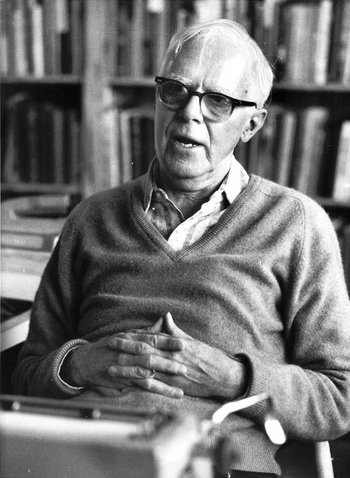 OF those strange things that I always automatically assume that anyone I know or have had dealings with cannot, by any stretch of the mind, be considered famous or well-known. The falseness of this assumption was made apparent to me when I picked up this week’s Economist after it arrived through the mail slot. As usual, there were a number of fascinating and well-informed articles, on the airlines of the Gulf, on the Colombian election, a special report on South Africa, and more. But then I finally reached the end pages and read the full page obituary of “Martin Gardner, man of letters and numbers,” who died on May 22nd at 95 years of age.
OF those strange things that I always automatically assume that anyone I know or have had dealings with cannot, by any stretch of the mind, be considered famous or well-known. The falseness of this assumption was made apparent to me when I picked up this week’s Economist after it arrived through the mail slot. As usual, there were a number of fascinating and well-informed articles, on the airlines of the Gulf, on the Colombian election, a special report on South Africa, and more. But then I finally reached the end pages and read the full page obituary of “Martin Gardner, man of letters and numbers,” who died on May 22nd at 95 years of age.
I never met Mr. Gardner but interacted with him several times during my New Criterion days by phone, and good old-fashioned post. He was a regular though not a frequent contributor to the magazine and was singular in that he was the only writer with whom the editor did not have the option of contacting via that nebulous mystery called the world-wide web. It was often, I confess, a source of some frustration that one would have all ones eggs in a row regarding pieces edited and signed off, and then there’d be something to do with Martin Gardner’s work and one would think “Blast! You mean I’ve got to stick this in an envelope to get the final OK?” Of course, when The New Criterion was founded, there was no internet, so there was a time when the whole magazine — indeed when every magazine — was put together via what I called the Martin Gardner method.
This aspect notwithstanding, it was always a pleasure working with Mr. Gardner, who was unfailingly polite over the phone when he would call in with his changes to our edits. It’s one of those inevitable aspects of death that one often discovers more interesting facts about the deceased than one ever knew while he was alive. In Martin Gardner’s case, it’s that this science maven published a number of annotated editions of works by G. K. Chesterton.
Roger Kimball writes of his last contact with Martin Gardner just a short time ago:
I wrote to tell him about the coincidence that a good friend now occupies the house he lived in for decades on Euclid Avenue (how’s that for an appropriate name?) in Hastings-on-Hudson, New York. I discovered this quite by accident. My wife and I were having dinner with a few other people at our friends’ house. I can’t remember Gardner’s name came up, but when it did I mentioned that he had lived for many years in Hastings-on-Hudson. “Yes,” said my friend, “and he lived in this very house.” One of the other couples present also knew Gardner. They recalled the time he invited them, shortly after they had moved to the neighborhood, to his house for drinks. Would it be alright if they brought their young children along, since no baby-sitter was available? Of course, nothing could be more agreeable! They arrived and Gardner proceeded to entertain the children with magic tricks for two hours.
My favourite story, however, is that he once wrote a devastating review of one of his own books and got it published under a pseudonym in the New York Review of Books. While he was a noted contributor to numerous sceptical reviews, he did come to a belief in God late in his life. “His declaration,” The Economist writes, “of this belief caused, he admitted, profound shock to those who knew him only as a sceptic. But there was too much playfulness in Mr Gardner to make him yield entirely to reason. His faith, he said, was based on an “emotional turning of the will”, unsupported by logic or science. It was his way, perhaps, of recognising that mind and man are not synonyms.”
Requiescat in pace.
Search
Instagram: @andcusack
Click here for my Instagram photos.Most Recent Posts
- Burns Tower April 19, 2024
- Patrick in Parliament March 18, 2024
- Articles of Note: 13 March 2024 March 13, 2024
- Cambridge March 9, 2024
- Taken on Trust March 4, 2024
Most Recent Comments
Book Wishlist
Monthly Archives
Categories


